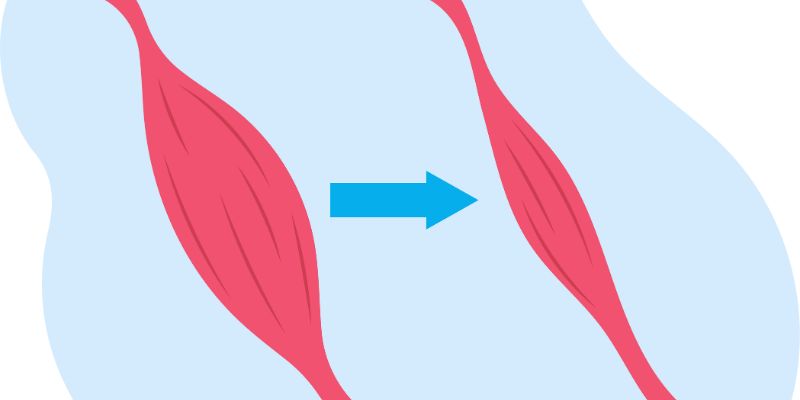Recognizing the Serious Symptoms of Muscle Atrophy: What You Need to Know
Advertisement
A disorder causing muscle mass decrease is muscular atrophy. It happens for various reasons, including lack of activity, nerve injury, or physical illness. This illness can cause the body to weaken, thereby making regular activities challenging. Early identification of the symptoms will enable efficient therapy. While some symptoms are faint, others point to major medical issues. Ignoring the warning signals might cause long-term damage.
This article will cover the major symptoms of muscular atrophy and discuss when one should get medical attention. Early intervention depends on awareness of the factors causing the symptoms. Maintaining knowledge regarding muscular weakening and loss helps one avoid more health problems. Early identification of the symptoms can help you move toward recovery.

Symptoms Of Muscle Atrophy
Here are some symptoms of Muscle Atrophy:
Unexplained Muscle Weakness
Sudden weakness is one of the first indications of muscular atrophy. The impacted muscles grow brittle and incapable of carrying out regular tasks. Anywhere throughout the body is possible for this. You could find it difficult to stand, walk, or lift goods. The fast development of frailty could point to a major problem. Still, another warning indicator is a loss of grip strength. People could struggle to open jars or spill things often. Usually starting gently, muscle weakness gets worse with time. Ignorance of treatment could cause irreversible injury.
Another problem can be a lack of mobility or extended bed rest. Muscle weakness and loss can greatly affect daily activities. Medical advice can assist in finding the reason and stopping further decline. Exercise and physical treatment could help muscles recover their capacity.
Noticeable Muscle Shrinking:
Muscle atrophy is the obvious loss of muscles. The afflicted portions seem smaller than those of neighboring muscles. Muscle degradation rather than weight loss accounts for this reduction. One finds it in the arms, legs, or other bodily parts. A leg that seems thinner than the other could be indicating atrophy. Ignoring the problem early on could make it worse. Strength and balance can change depending on muscle size loss. Clothes could fit just loosely around impacted areas. Often indicating nerve or muscle problems, this symptom of Lack of physical exercise speeds up muscular shrinking. Therapies and regular exercise help slow down the development. Severe movement problems can follow from advanced muscular degradation. Imaging and tests let a doctor determine the underlying problem.
Difficulty in Performing Daily Activities
Simple exercises become difficult when muscles weaken. Activities like getting out of a chair or ascending stairs could be trying. Those with muscular atrophy typically find it difficult to walk great distances. Lifting anything, including light objects, gets tough. Daily tasks like brushing hair or getting dressed require more effort. Movement speeds drop-down, and coordination suffers over time. Even with little exercise, fatigue strikes fast. Loss and weakening of muscles can lower general energy levels. Independent life can be more difficult with this condition. If such problems persist, medical advice is required. Ignoring these indicators can cause more problems. Treatment and counseling can help one get strength again. General health and well-being depend on keeping mobility.
Increased Risk of Falling and Poor Balance
Coordination and balance can suffer from muscle loss. Weak muscles battle to support bodily weight appropriately. That makes one more likely to trip and fall. Fall-related major injuries include head trauma and fractures. Those with extensive muscular degradation may find themselves misstepping often. Long stretches of standing can become taxing. The body can seem unsteady, which would make mobility challenging. Common problems also are poor posture and slouching. Especially on uneven ground, walking could seem unstable. Many times, weak leg muscles cause abrupt loss of balance. Falls could cause one to lose faith in their mobility. Physical treatment lowers hazards and increases stability. Strength training could help rebuild weak muscles. Seeking medical advice helps stop more deterioration.
Numbness or Tingling Sensation
Muscle atrophy linked to nerve damage could produce tingling or numbness. Usually, the arms, legs, or hands experience this sensation. The afflicted regions could feel dead or feeble. Some people get a scorching or prickling feeling. This complaint can point to nerve injury or compression. Affected muscles might not react nicely for movement. Numbness might cause total loss of sensation over time. That makes wound or injury detection challenging. Bad blood circulation can aggravate these symptoms. Ignoring problems connected to nerves might cause major consequences. Muscle weakness and loss brought on by nerve injury call for quick medical intervention. Treatment can call for physical therapy or drugs. Early diagnosis can help to avoid long-term damage.

Pain or Cramping in Muscles
Muscle shrinkage can be uncomfortable or cause cramps. Weak muscles battle to support movement, which causes pain. Cramps might strike quickly and linger several minutes. The afflicted muscles could seem stiff or tight. The degree of atrophy will determine whether the pain is minor or severe. Some people find weak muscles to be always painful. A typical complaint is also nighttime cramps. Inactivity or strain prolongs pain. The body could recuperate from effort more slowly. Muscles and joint stiffness can lower flexibility. If muscle aches persist, medical attention is required. Among the available treatments are therapy, massage, and stretching. Maintaining activity helps control muscle soreness.
Reduced Reflexes and Slow Movements
Reflexes and movement speed change with muscle atrophy. The body reacts gradually to abrupt movements. Reflex testing could reveal slowed response times. Slower motions complicate daily chores. Affected muscles have lost their efficiency in the past. Weak muscles fight to execute coordinated movements. Mobility starts to become increasingly limited with time. Reflex loss can point to nerve injury. Those with advanced muscular degeneration could feel lazy. Reaction times slow down dramatically. Object handling or driving can get difficult. Part of movement can be restored with physical therapy. Stretching and strength-building activities enhance reflex responsiveness. Early addressing of these symptoms helps to stop more deterioration.
Conclusion:
Daily living and mobility may suffer from muscle atrophy. One must first identify the severe indicators of muscular atrophy. One should not overlook weaknesses, muscle shrinkage, and balance problems. Early diagnosis helps avoid major issues. Loss and weakness of muscles can lower general strength and health. The first symptom of problems should be taken under medical attention. Proper therapy and exercise can help stop progression. Advanced muscular degeneration calls for expert therapy. Keeping an active lifestyle helps stop muscular loss. Knowing the symptoms lets one start early intervention. Acting might increase general well-being and mobility.
Advertisement












